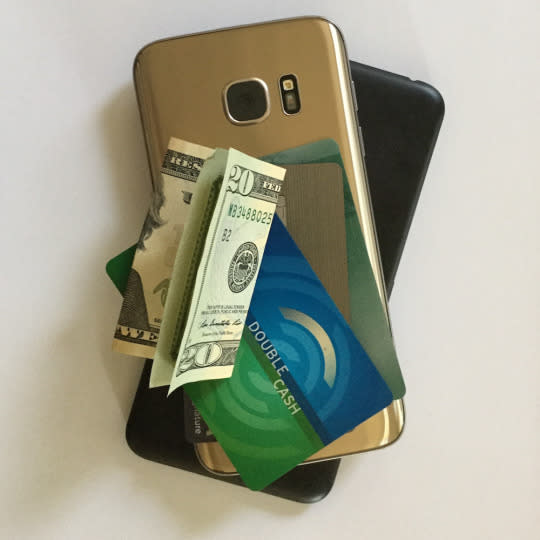Don’t take my money: Why mobile payments haven’t taken off — yet

Image by Rob Pegoraro/Yahoo Tech
A buck says you won’t buy your next tank of gas or bag of groceries with your phone.
Given all the hype about Apple Pay, Android Pay and Samsung Pay — the three major mobile-payment systems that let you pay by touching a smartphone to a credit-card reader, while leaving your wallet in your pocket or purse — you might think that’s a sucker’s bet.
But all that publicity has yet to translate into large-scale adoption.
Slow going
The fact is, as of October 2015 (according to the latest quarterly survey conducted by PYMNTS and InfoScout), just 16.6 percent of iPhone 6 and iPhone 6 Plus users had tried Apple Pay. And of those iPhone users who had tried Apple Pay, only 35 percent said they used it regularly — down from 48 percent six months earlier.
A second survey by the mobile-research firm Crone Consulting found equally discouraging numbers for Android Pay and Samsung Pay. Among the 5 million Android Pay users, only 1 percent used it for at least two transactions a month; among 5 million Samsung Pay users, just 4 percent used it that often.
(As for Apple Pay, Crone estimated 12 million users, of which 6 percent met that two-transaction minimum.)
“Repeated and consistent use is stalled,” IDC payments analyst James Wester said in an email. “That means it’s still a novelty to most consumers — something they use once to try it but don’t use it as a replacement for cards.”
With good and bad reasons
The biggest virtue of phone payments — the security enabled by a smartphone app that doesn’t transmit your real credit-card number — is invisible in practice to the customer. And when traditional cards get compromised in a data breach, you aren’t stuck paying fraudulent transactions anyway.
(You are stuck with the inconvenience of changing saved card information across the Web — an annoyance I’m dealing with now, after an online purchase made with one of my cards at a Ukrainian merchant I’ve never heard of.)
The InfoScount/PYMNTS data suggest many users are confused on that issue: The latest survey found 18.7 percent of Apple Pay holdouts had security concerns about one of the most secure payment technologies available.
More importantly, many retailers have yet to accept phone payments. Infamously, CVS and a few other retail chains disabled the feature in their stores in a doomed attempt to push a competing mobile-payment system called CurrentC. That system relies on scanning QR codes instead of using the Near Field Communication (NFC) short-range wireless technology employed by Apple Pay, Android Pay, and Samsung Pay.
Samsung Pay can also emulate a credit card’s traditional magnetic stripe, allowing you to hold your phone against a credit-card reader and see the transaction completed wirelessly.
That’s a genuinely neat trick. But as my colleague Daniel Howley has noted, Samsung Pay remains a nonstarter at gas pumps and any other card reader that requires inserting a card.
There’s also the pesky problem of restaurants. Until U.S. establishments adopt the overseas practice of having a waiter or bartender bring a card reader to you, you’d have to hand over your smartphone to the staff to pay using this method.
Finally, once introductory promotions — such as the $30 gift cards Samsung offers to Galaxy S7 and S7 Edge owners who make a Samsung Pay purchase — expire, you rarely save money by paying with your phone.
(Note that on Verizon’s versions of those phones, Samsung Pay isn’t pre-installed, so you’ll have to download it from the Play Store yourself — as if mobile payments needed any more speed bumps.)
Change will come … slowly
This is not to say that mobile payments are doomed to remain a curiosity. If you look past the big three NFC-payment apps and include chain-specific payment apps (such as the one from Starbucks), its prospects look brighter.
Factoring those in, Crone founder Richard K. Crone said in an email, “Mobile payment is growing 10 times faster than mobile banking ever did, accelerated first by retailers, and we are just getting started.”
Jason Oxman, CEO of the Electronic Transactions Association, called for patience — “like all technology migrations, mobile payments adoption takes time” — but also pointed to an eMarketer study that predicted a 210 percent increase in the total value of U.S. mobile payments this year.
Oxman added that, as stores upgrade their credit-card readers to support the EMV chips in new cards, that new hardware also often includes NFC support. In some cases — hello, Whole Foods! — retailers have enabled NFC payments while leaving EMV support off.
Wester and Crone predict that mobile-wallet apps that reward frequent customers with personalized offers will get more people to pay with their phones.
I might as well note here that I’m part of the problem. The only times I’ve used my phone to pay for things that didn’t constitute story research have been in Chicago, where paying with my phone at an El fare gate lets me avoid the 50-cent surcharge on paper tickets.
(Washington’s Metro officials have been trying a similar NFC-compatible system, but that project has stalled.)
Wester confessed that he, too, is a situationally apathetic about mobile payments. “I still use the Starbucks app consistently (thanks to rewards),” he said. “But otherwise I have to remember to use my phone.”
Email Rob at rob@robpegoraro.com; follow him on Twitter at @robpegoraro.

